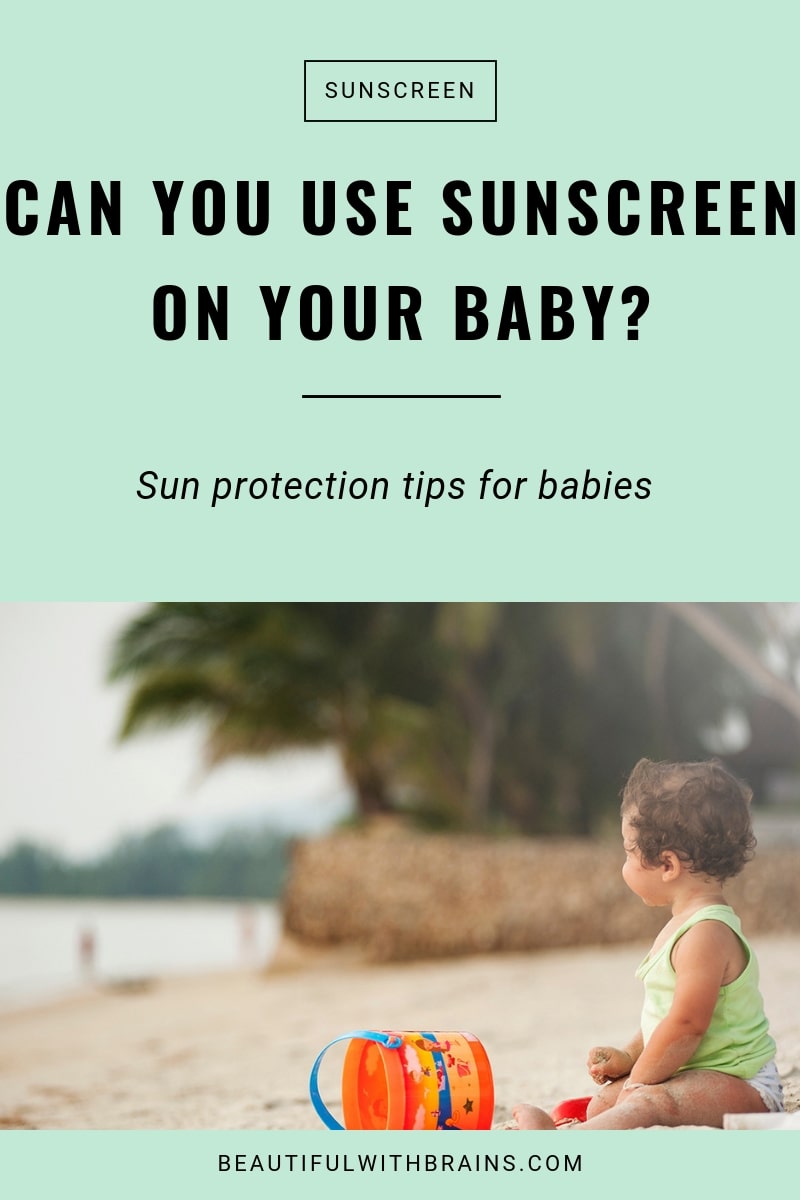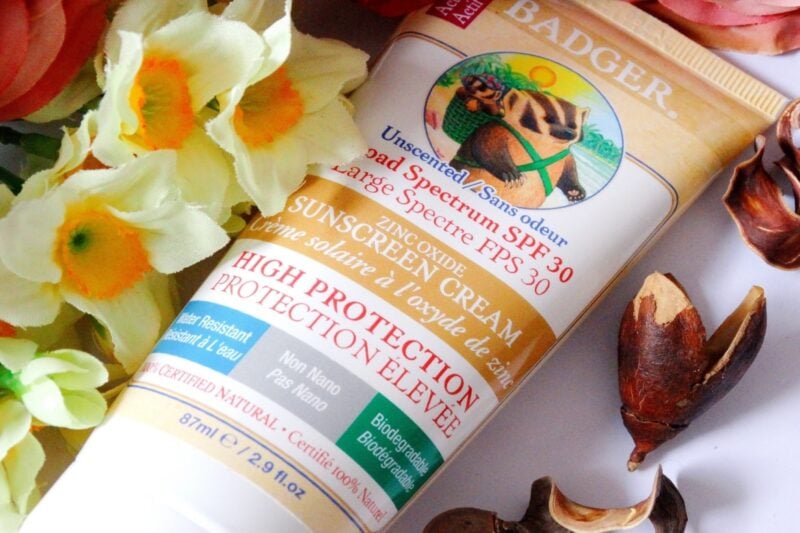
I know you’re putting on sunscreen every morning, RIGHT? But do you use it on your baby too?
Sure, you could argue that 6 months is way too young to start worrying about wrinkles – and you’re totally right. When you have a baby, that’s the least of your concerns.
But forget about wrinkles for a while. What about sunburns that could increase the chances of your child getting skin cancer later on in life? Or the sun damage you don’t see now but that shows up unannounced years down the line?
Your child will thank you if you start his/her sun protection early. But how early is too early?
Is Sunscreen Dangerous For Babies & Young Children?
I wouldn’t sun sunscreen is dangerous for babies and young children. But you have to be double careful what you use on their skin.
Infants’ skin is thinner than adults and not fully-developed yet. UV filters penetrate it more easily.
Plus, compared to adults, babies have a higher surface-area to body-weight ratio. Translation: proportionately infants have more skin for the size body as compared to an adult.
This means that an UV filter that’s 100% safe for adults is more likely to cause allergies and irritations in babies.
So, what are you supposed to do, skip the sunscreen?
Yes, but only for a while…
Related: What To Do When You’re Allergic To Sunscreen
How effective is your sunscreen? Sign up to the newsletter below to receive the “Sunscreen Audit” Worksheet and find out if your sunscreen is really up to the job:
Babies Under 6 Months Old Don’t Need Sunscreen
If your baby is under 6 months, you do NOT need to apply sunscreen on him/her. But how to keep your precious baby safe from UV harm then?
Hari Cheryl Sachs, M.D., a pediatrician at the Food and Drug Administration (FDA) believes that “the best approach is to keep infants under 6 months out of the sun, and to avoid exposure to the sun in the hours between 10 a.m. and 2 p.m., when ultraviolet (UV) rays are most intense.”
If you can’t keep your baby in the shade, Sachs suggests to make them wear lightweight protective clothes. Avoid fabrics that keep bodies too warm. Baby can’t cool down with sweat yet and when they’re too hot, they are at risk of becoming dehydrated.
Don’t forget to add a wide-brimmed hat and glasses!
Related: 7 Ways To Protect Your Skin From The Sun
If Your Baby Needs Sunscreen, Use A Mineral One
What if your baby is six months or older and can start wearing sunscreen?
The safest sunscreen for babies and young children uses mineral UV filters, i.e. zinc oxide and/or titanium dioxide.
Synthetic UV filters like Avobenzone and Oxybenzone are more likely to cause irritations. Plus, they can be absorbed by the body.
FYI, just because an UV filter can penetrate the body, it doesn’t mean it’s toxic. In the cases of Avobenzone and Oxyebenzone, your body simply gets rid of them through urine.
At least, that’s what happens in adults. We don’t have any studies on how these sunscreens work when absorbed into babies’ bodies (for obvious reasons!), so dermatologists recommend you opt for mineral UV filters that safely stay on the surface of their skin.
Related: 3 Reasons Mineral Sunscreens Are Best For Children and Sensitive Skin

What Are The Best Sunscreens For Babies?
FYI, if you’re using a mineral sunscreen for yourself, you can safely use that on your baby, too. But if you prefer your baby to have his/her own, here are the best sunscreens for babies:
- Badger Baby Broad Spectrum SPF 30 (£16.99): available at iHerb
- Blue Lizard Baby Lizard Australian Sunscreen SPF 30 ($19.99): available at iHerb and Walmart
- Neutrogena Pure & Free Baby Mineral Sunscreen With SPF 50 ($10.97): available at Walmart
Related: Can You Use Your Child’s Sunscreen?
The Bottom Line
Once your kid is 6 months old, you can start applying sunscreen on him/her. Just make sure you opt for a mineral formula. Synthetic UV filters tend to be too harsh for babies and young children.
Do you apply sunscreen on your baby? Share your thoughts in the comments below.


Great information for new moms out there. My daughter was born in June & so her first summer was spent in the shade. The following year, when she turned one, light clothes, hats at all time and a sunscreen on exposed parts I still made her play in the shade as much as possible & avoided the high sun periods of the day as much as possible.
What I’ve observed over the years is that many moms will stop or be less dilligent about sunscreen once children become active, around 7 or so. That’s when it’s super important to impose it. That way kids get into the habit of using it. My daughter will be 14 this year and outdoor activities are not considered by her if she’s not wearing sunscreen. 🙂
Icaria, what a smart mom you are! Well-done for keeping your daughter protected from the sun rays and teaching her to always use sunscreen. I wish more parents did that. Here, most moms apply sunscreen on their children only at the beach, but it’s important to wear it whenever we go out in the sun.
I’m surprised what they say about kids under six months, but I guess it makes sense. And honestly, I think even adult sunscreens should mostly be physical and not chemical. Some chemical sunscreens irritate my skin. It’s something I’ve deduced only recently, but I think it might be octisalate. I think that’s how it’s spelled. So, I avoid it.
But the thing is, you can’t tell by looking at me that my skin is irritated. I can feel it, not see it. So, you would never know if your kid is hurting unless they can say it. And a baby definitely can’t say it.
Trisha, I agree. I prefer physical sunscreens too. Chemical ones work well, but they are much more likely to cause irritations and since we have a better alternative, why not use that?
I always did use sunscreen on my babies (and continue now that they are children). I must admit I probably did use zinc oxide based ones before six months – your article is interesting 🙂 They have inherited my very pale/freckled/ginger colouring, and believe me, we really HAVE to apply the SPF. It’s probably lucky in a way, as we’re never tempted to over-do the sun, as we will suffer – both seen AND unseen damage. I still remember the pain/blisters when, as a young teenager fed up with being pale, I was persuaded by a friend to try her Ambre Solaire tanning oil – no SPF, just oil. NEVER AGAIN.
Viv, tanning oil is so bad! I’m sorry you had to find out the hard way. But it’s great that you and your family always use sunscreen. It does prevent a lot of damage. And if you have to apply sunscreen on infants, then you want it to be a physical one. The main problem is that their skin isn’t fully-developed yet, but zinc oxide is gentle and shouldn’t cause problems. It’s still better to keep them out of the shade whenever possible though.
Thanks for this especially I’ll be a mom soon! I appreciate all these tips for babies 😀
Nikki, you’re very welcome. And congratulations! 🙂
To parents who protect their kid’s skin, bless you; you are doing one of the greatest favors for your child. My parents never applied sunscreen to me unless we were going to the beach or swimming and even then, we wouldn’t reapply. To this day, even after I lectured them on all the dangers of sun exposure, they don’t listen. Ah, well. 😮
And so I am feeling so grateful I found your blog. You made me fully aware of how important sunscreen is and what true beauty really is. I’ve also found lots of other websites I regularly read thanks to you.
<3
Janessa, it’s great that more and more parents understand the important of sunscreen and apply it on their children too, isn’t it? Unfortunately, my parents are the same as yours. Even now, they don’t get it. Ah well, it’s their skin. *sighs*
Aww you’re very welcome. That’s exactly the reason why I started blogging and keep at it. Bless you. 🙂